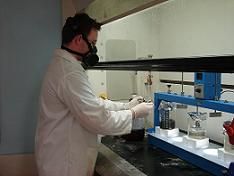Using Entrapped Cell Systems for Treating Supernatant from Anaerobic Digester of the Moorhead Wastewater Treatment Plant

Christopher Hill has B.S. in Civil Engineering from North Dakota State University and is currently pursuing a Masters in Environmental Engineering at North Dakota State University. He is currently studying the removal of nitrogen from wastewaters with high ammonia using entrapped cells. He is an active member and currently holds the position of treasurer in NDSU’s WEF/AWWA Student Chapter.
Email: Christopher.hill@ndsu.edu
Fellow: Christopher Hill
Advisor: Eakalak Khan, Ph.D., P.E., Assistant Professor, Department of Civil Engineering, North Dakota State University
Matching Support: Advisor’s salary and tuition waiver (In-kind matching)
Degree Progress: Masters in Environmental Engineering expected in May 2007.
Using Entrapped Cell Systems for Treating Supernatant from Anaerobic Digester of the Moorhead Wastewater Treatment Plant
Nitrogen is essential for life but when mismanaged can cause a negative impact on the environment. There are many sources of nitrogen released into the environment but the focus of this research is wastewater with high ammonia, which is difficult to treat using conventional wastewater treatment systems.
Project objectives:
The main scope of this study is to investigate the use of entrapped cells (nitrifiers and denitrifiers) for removing N in the supernatant from the anaerobic digester of the Moorhead wastewater treatment plant (WWTP). The specific objectives of the study are as follows:
1) To investigate the ability of a separately entrapped nitrifier-denitrifier laboratory scale system for treating N in the supernatant,2) To investigate the ability of a homogenous co-entrapped nitrifier-denitrifier laboratory scale system for treating N in the supernatant, and3) To compare the N removal performance of the separately entrapped and homogenous co-entrapped nitrifier-denitrifier systems.
Progress:
Nitrifying and denitrifying bacteria are slow growing cultures. Progress thus far has been the cultivation of these bacteria. In the near future, the bacteria will be entrapped.
Significance:
This research will demonstrate for the first time the performance of entrapment cell systems on the treatment of high strength wastewater. It will greatly benefit not only the Moorhead WWTP but also WWTPs that receive and/or recycle high strength wastewater streams such as landfill leachate and centrate. If the results of this study show that an entrapped cell system is a promising alternative for treating N in digester supernatant, there is a high possibility that the system will also be applicable to other types of high strength wastewater. The upset of wastewater treatment process due to the return of digester supernatant and centrate is one of the most common problems for WWTPs. The outcome of this project may have a potential to minimize the risks of plant failure and discharge permit violation.

Eakalak Khan
Civil & Environmental Engineering
NDSU


